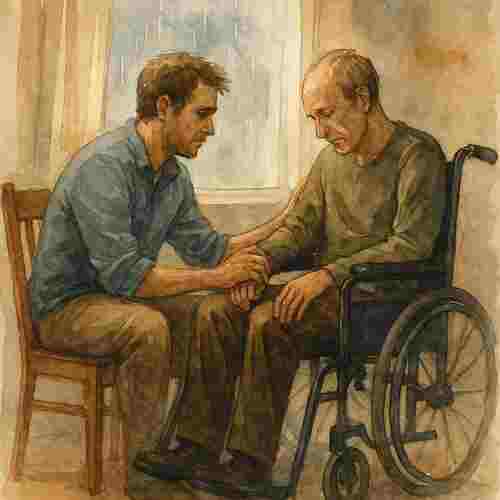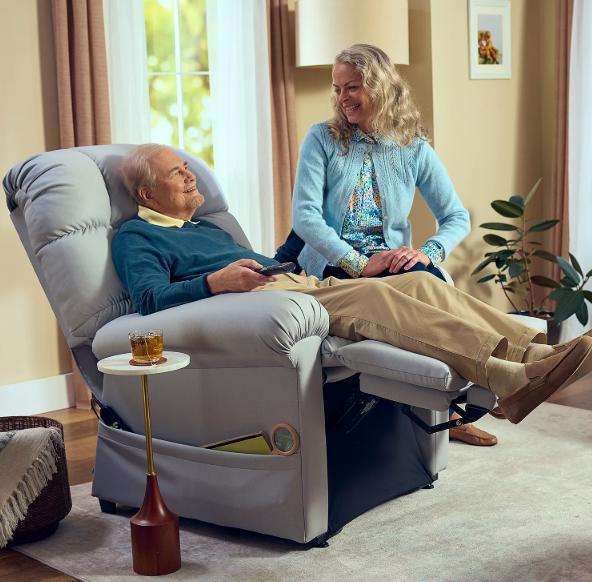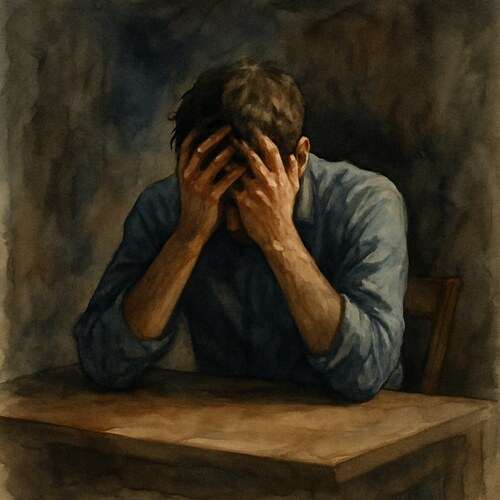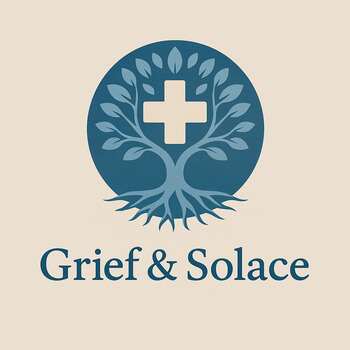Grieving ALS: Facing the Slow Loss of Strength and Self
Grief with ALS begins with small slips, the lost grip, the missed step—and grows heavier as the body fades but the mind stays painfully aware.

This post blends real grief with grounded knowledge. It isn’t clinical. It isn’t distant. It’s meant to sit beside you—not above you. The story you’ll read is meant to reflect what so many feel when living through or witnessing this condition: confusion, exhaustion, and quiet forms of courage.
If what you read feels familiar, please speak with your doctor. Your pain deserves more than silence.
The Day His Hands Couldn’t Button His Shirt
I used to hear his voice through the walls, always humming, always talking, always laughing at something I couldn’t hear. It didn’t matter what it was; the house had a rhythm because of him. Not just his words, but the way he moved, the thump of footsteps down the hall, the curse when he dropped a spoon, the sound of a real, full life being lived.
🧠 Symptoms:
- Progressive muscle weakness (legs, arms, speech, swallowing, breathing)
- Twitching, cramps, clumsiness, and slurred speech
- Emotional lability: untimely crying or laughing
- Cognitive or behavioral changes in some individuals
- No sensory impairment; bladder and pain generally unaffected
Then came the stumble…just one, at first, a trip over nothing, a toe that didn’t lift high enough. He laughed it off, called it a sign of getting older, and said “We needed to stop buying cheap shoes”.
But his laughter cracked a little, even then; and I felt it, somewhere beneath the jokes and the shrugs…something had shifted, He was afraid.
After that, it moved quickly: appointments, scans, the silence in the exam room after the doctor used the word “degenerative.” I remember how still he went, not even blinking, like if he didn’t move, it wouldn’t be real yet. “ALS, amyotrophic lateral sclerosis”; they said it like it explained everything.
But it didn’t; it only made the questions heavier.
His hands were the first to betray him. He used to build things: furniture, models, and little toys for our niece. But suddenly, the screws wouldn’t turn, his grip gave out; He dropped a coffee cup that shattered like a gunshot, and we both jumped! Though neither of us said anything He tried again, and again, until…he just stopped trying.
His voice was next to follow. He used to tell stories that made people cry from laughter. Now, even a sentence cost him, his breath came unevenly, and his words blurred into each other. He started using a tablet to type out what he needed, but that was worse, somehow; not because of the technology, but because it reminded us both that he couldn’t speak in real-time anymore. His jokes had to wait now; his wit…delayed, translated, diluted.
Complications:
- Respiratory failure is the leading cause of death
- Difficulty speaking; many require assistive communication
- Swallowing issues can lead to malnutrition or pneumonia
- Potential development of frontotemporal dementia
- Increasing dependence on assistive devices for daily functions
Causes:
- Progressive loss of motor neurons (both upper and lower)
- Neurons stop sending signals, leading to muscle atrophy
- ~10% of cases are hereditary; most causes remain unknown
- Likely interplay of genetic and environmental factors
He was still in there, every bit of him. But his body became a prison cell with windows that wouldn’t open. And I—I was the one watching from the other side of the glass, trying to guess what he was thinking while pretending I didn’t see the grief pooling behind his eyes.
People don’t talk enough about the rage, the rage of watching someone you love slip away in pieces, knowing exactly what’s coming but not when. It’s like drowning in a lake you’ve memorized; you know every inch of it, but it still takes you under…slowly, cruelly.
And no one wants to say how tired you get, how angry, how unfair it is to cry in private because your tears make them feel guilty for surviving.
He started needing machines, a lift to help him bathe, a suction device when he choked, and a monitor when he slept. The house was filled with blinking lights, mechanical sounds, and soft beeps that made it feel more like a hospital than a home. He was still him…but the world around him forgot. Visitors stopped coming, calls slowed; no one knows how to sit with grief that doesn’t end in a funeral, only in waiting.
I did everything I could, but there were nights I… broke…nights I screamed into pillows, nights I prayed he’d fall asleep and not wake up, not because I wanted to lose him, but because I couldn’t bear watching him lose more of himself. And the guilt of that thought… it’s something I’ll carry long after the diagnosis is gone after he’s gone.
But he isn’t gone yet. He still looks at me with those same sharp eyes, still types out jokes, (even if they land a minute late), still listens to music, and insists I read to him, even when I’m tired.
He’s teaching me how to love someone who is dying, and how to stay alive beside them.
This is not a battle, not a war, not a race; it’s a slow surrender, where the victory is showing up one more day. Where the only thing louder than the silence is love.
Risk Factors:
- Genetics: 10% of ALS cases are familial
- Age: Most common between 60–85 years old
- Sex: Slightly more common in men before age 65
- Smoking: Especially risky for women post-menopause
- Environmental toxin exposure (lead, chemicals)
- Military service: Possibly linked to trauma, exertion, infections
📘 Diagnosis & Treatment
Diagnosing ALS is complex, especially early on. Symptoms can mimic other neurological or muscular conditions, requiring a process of elimination.
Diagnostic steps include:
- Electromyography (EMG) and Nerve Conduction Studies to assess muscle activity and nerve function
- MRI scans to rule out structural issues in brain/spinal cord
- Blood and urine tests for signs like elevated neurofilament levels
- Spinal tap (lumbar puncture) to check for other causes
- Muscle or nerve biopsies if alternative diseases are suspected
There is no single test for ALS, and diagnosis typically involves a neurologist and a coordinated care team.
Treatment Approach:
ALS has no cure, but several treatments extend life and improve quality:
Approved Medications:
Riluzole: Oral medication shown to extend life expectancy (~25%)
Edaravone: IV or oral therapy that slows decline in daily function
Symptom Relief:
Medications to manage cramps, excess saliva, depression, sleep issues, urinary urgency, and emotional outbursts
Coping & Long-Term Planning:
- Grief and mourning are natural after diagnosis
- Hope and focus on meaningful activities can extend quality of life
- Advance care planning is encouraged early in the process
- Support groups benefit both patients and caregivers
- Many choose to participate in ALS research or clinical trials
Respiratory therapy: Non-invasive ventilation or tracheostomy
Physical therapy: Maintain strength, mobility, and independence
Occupational therapy: Adaptive tools for daily tasks
Speech therapy: Techniques and devices for communication
Nutritional support: Feeding tube when swallowing becomes unsafe
Psychological and social support: Counseling, care planning, grief processing
I know this is heavy, and I understand that the road ahead may feel like a tangle of loss and unanswered questions. But please hear this: you are not broken because you are hurting; you are not weak because you are afraid. You are living through something real, and survival itself is a kind of grace. You are allowed to struggle, you are allowed to hope, and you are allowed to not have all the answers today. Whatever comes next, you do not face it empty-handed; you carry every moment of love that shaped you, and that will always be enough to keep going.
🎀 Gifts to help With ALS (Amyotrophic lateral sclerosis)
🏥 Everyday Comforts for Everyday Battles
Managing ALS (Amyotrophic lateral sclerosis) often means needing a little extra help.
Sometimes it’s about restoring dignity, ease, or simply getting through the day with less pain.
These carefully chosen tools aren’t just items, they’re small bridges back to living.
This section is about finding practical support, never shame.
Adjustable Sit-to-Stand Recliner Chair for Progressive Mobility Needs
As ALS progresses, the simple act of standing can feel like lifting a mountain. This motorized recliner is designed for exactly that—giving users the power to rise gently, safely, and with dignity. Its wide base, ergonomic cushioning, and easy push-button control make it a perfect support system for fatigue and muscle weakness. It’s more than furniture—it’s a lifeline in the living room.
🌿 Paths to Healing Beyond the Map
Sometimes traditional medicine isn’t enough.
If you’re exploring gentle, alternative options to help with ALS (Amyotrophic Lateral Sclerosis),
you might find comfort in plant-based compounds like **CBD or CBG**.
*This section is not medical advice, just a door left open.*
CBD Muscle Relief Drops – Soothing Support for Stiffness & Spasms
ALS doesn’t just weaken—it seizes. These broad-spectrum CBD drops are crafted to help ease muscle tension, calm nerve overactivity, and bring a little more comfort to those restless nights. THC-free and lab-tested, they’re a natural companion to more clinical treatments—gentle, non-invasive, and made for moments when you just need some stillness.
Need a Different Path Forward?
Every journey through grief looks different. Choose the next step that speaks to where you are now:
When You're Ready to Start Healing
Healing doesn’t mean forgetting.
It means finding small ways to carry your grief with strength and grace.
These are the stories, tools, and gentle steps to begin walking forward…at your own pace.
When You're Still in the Thick of It
Sometimes healing feels like a lie.
If you’re not ready to move on…if the pain still roars louder than the world wants to hear…this is the place where you’re allowed to feel it.
No sugarcoating. No pretending. Just truth.
When You're Holding on to Who’s Still Here
Grief reminds us to love louder.
If someone you love is still with you, this is your place to celebrate them, honor them, and create new memories while there’s still time.
Joy and sorrow can live side by side.






